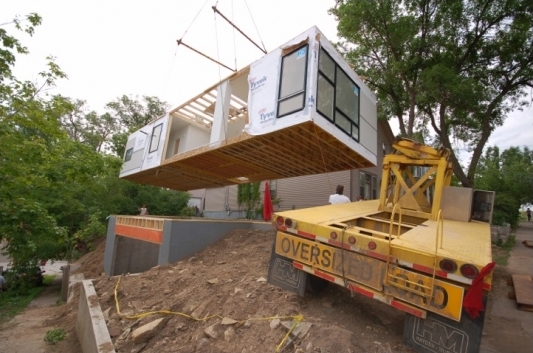Step 3: Locally-Generated Data/Input
Local data can also inform the development of a housing element. Jurisdictions are most familiar with the amount and availability of existing land uses for residential occupancy and greenfield or infill land for residential development. They also have the planning and zoning authority necessary to amend local land use and zoning to address additional housing needs.
-
Acreage of land by residential zoning district: By comparing the availability of land designated and/or zoned for residential uses with the estimated and projected future population, a jurisdiction can assess whether its current land use plan will meet the housing needs of existing and future residents, and if land currently zoned for other uses should be rezoned to residential.

Modular Home Construction
-
Residential density by zoning district or planning area: Permitted residential density varies by zoning district. In addition to an inventory of land designated or zoned for residential use, a jurisdiction can also consider the approximate unit density of its existing and future residential areas. For example, R2 may permit 3.5 dwelling units per acre, while R4 will permit eight. The following steps outline a simplified process to calculate the potential number and types of units existing residential zoning can accommodate. These calculations may not be applicable to municipal growth areas that do not yet have an assigned land use or zoning classification.
Note: Planning stresses that this is just an example process and will not apply to all jurisdictions. These steps will likely need to be modified to meet the specific local conditions.
Step 1: Sum currently developed and greenfield residential land acreage by residential zoning category
Step 2: Multiply the acreage of each zoning district by its average approved unit density per acre, and confirm sewerage capacity
Step 3: Sum the figures of all districts, as calculated in Step 2 to estimate how many units the current land use plan and zoning will accommodate.
Step 4: If desired, these calculations can be distinguished by planning areas.
Step 5: These figures can then be compared to population projections and/or average household sizes to determine if more land and/or residential density is needed. The Dashboard includes current average household size, and the State Data Center calculates
household size projections by county.
As part of this process, a jurisdiction planning for affordable housing should also consider if its existing residential densities provide enough housing diversity for households at a variety of income levels.
Assets and opportunities: A jurisdiction may want to consider its residential assets and opportunities when preparing a housing element by seeking the answers to important questions, which include but are not limited to:
What is the quality of existing housing stock?
Is it energy efficient?
Is the existing balance between homeownership and renting desired?
Are there areas or neighborhoods that require additional resources to improve the housing stock and ensure its continued maintenance?
Is there land available for residential or mixed-use development that would include affordable housing?
Is our housing stock contaminated with lead based paint, as all residential properties require lead assessments at the time of sale or transfer in rental occupancy?
Are there local organizational or employer partners that should be engaged in the development or maintenance of affordable housing?
Is the cost of housing rising or falling?
Do we need to expand our growth areas to increase the supply of housing?
Historical perspective and description of neighborhoods/residential districts: Residential neighborhoods are often historic community resources and lend a unique aesthetic and appeal. By tracing the historic development of neighborhoods, a jurisdiction can consider trends and characteristics that it wishes to preserve and encourage in its long- range planning. New residential development need not be on the outskirts of town, and a housing element should consider compatibility of infill development with the existing residential stock.
Assessment of Current Housing Condition: Local planners and community leaders are anecdotally familiar with the condition of housing in their communities but may want to consider qualitative and quantitative analyses to assess conditions while preparing a housing element more formally. Windshield surveys, combined with data such as Year Structure Built (Dashboard), local permitting and code violation information, and the usage of historic tax credits can provide a more complete picture of the strengths and needs of the existing housing stock.
Note: DHCD, through Community Development Block Grant funding, can assist Maryland jurisdictions seeking to conduct a housing needs study. For examples of how a housing analysis can combine ACS data with locally generated insight, see the City of Cambridge’s February 2019
Housing Market Analysis + Needs Assessment, the City of Rockville’s December 2016
Housing Market Analysis and Needs Assessment, and Somerset County’s August 2016
Substandard Housing Study Queen Anne’s County will be conducting a housing study in preparation for an upcoming comprehensive plan update, and they solicited consultants for the study with this early 2020 Queen Anne’s County will be conducting a housing study in preparation for an upcoming comprehensive plan update, and they solicited consultants for the study with this early 2020
request for proposals.